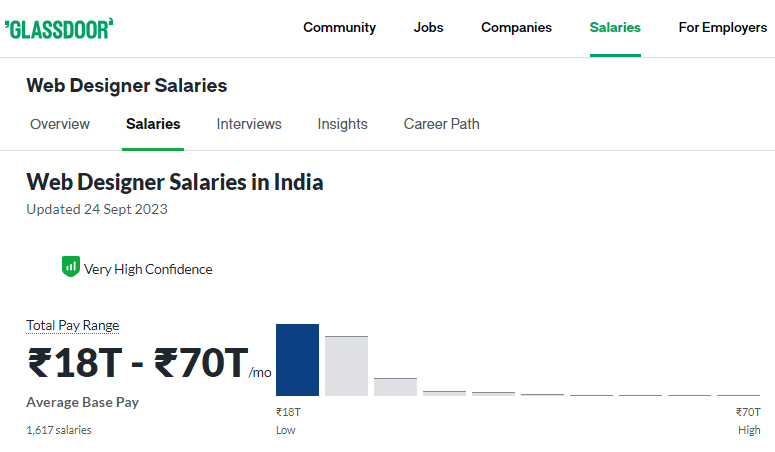What is a Web Design Course?
So, what's a web designing course in Surat all about? Well, it's like your backstage pass to the web creation show. With these courses, you will be able to equip yourself with the skills to create websites, graphic design, User Interface, UX, coding, and data management. The added advantage is - website design projects are generally hands-on, which will help you build up a portfolio showcasing your skills, which is like your golden ticket in the job market.Career Prospects in Web Design
Now, let's talk about career options. Web design is your gateway to a bunch of exciting paths: Web Designer: The obvious choice, right? As a web designer, you'll create websites that are both visually appealing and functional, using your design and coding chops. UI/UX Designer: These folks are all about making websites super user-friendly. They work hand in hand with web designers to ensure sites are a breeze to navigate. Front-End Developer: Ever wondered who turns those awesome web designs into interactive websites? These professionals are the front-end developers, they use languages like HTML, CSS, & JS to realize the designs in the form of web pages. Graphic Designer: These professionals generally take all the design-related load right beginning from designing the brand logos to the full website illustrations. They are responsible for connecting the brand identity with its customers through visual appeal. Freelancer: Fancy working on your terms? Many web designers go freelance, offering their services project by project. It's a flexible way to explore diverse projects. Web Design Instructor: If you're a seasoned web designer, you could become an instructor, passing on your wisdom to the next generation of designers. Also Read: Web Designer Career: Everything You Need To KnowTypes of Web Design Courses
It is very confusing for an aspiring web designer to choose the right course to build a career. As in the ever-evolving IT industry learning should be a continuous practice to maintain your competency. There are different options to learn Web Design either through Degree programs or Certification programs, some are listed below: Diploma Courses: These courses are apt for beginners who are looking to learn web designing in a short period yet are seeking a degree certification. Generally, these are shorter duration courses as compared to degree programs. Bachelor's Degree in Web Design: The bachelor's degree programs are lengthier in duration as compared to the diploma programs and are more comprehensive. Bachelor's programs stretch up to 4 years in most parts of the world. Master's Degree in Web Design: For those aiming higher, master's programs dive into advanced web design topics and often involve research. Online Courses: Can't commit to a physical classroom? No worries! Many online platforms offer web design courses you can tackle at your own pace.Fees for Web Design Courses in 2024
Fees for the Web Design Courses vary depending upon the type of courses and the institute/universities offering it, but stated below is a ballpark figure.| Type of Education | Cost Range |
| Diploma Courses | ₹10,000 to ₹50,000 per course |
| Bachelor's Degree | ₹1 lakh to ₹5 lakhs per year |
| Master's Degree | ₹2 lakhs to ₹10 lakhs (total) |
| Online Courses | ₹5,000 to ₹50,000 (varies) |
How to Get Admission to a Web Design Course After 12th?
It is a bit straight if you’re looking for a Web Design course after completing your senior secondary schooling. Some steps below will help you structure the right courses for you: Research: Start by exploring web design courses and colleges. Find alignment of subjects, professors, curriculum, and pedagogy, to stay hooked with interest. Eligibility Check: It is essential to check the eligibility for the course beforehand. Usually, you'll need to have cleared 12th grade with a minimum percentage. Entrance Exams: Some colleges might require entrance exams or interviews. Prep for these, they can make a big difference. Application Time: Fill in those application forms. Don't forget to attach all the necessary documents and pay the application fee if it's needed. Portfolio Power: Depending on your course, you might need to show off a portfolio showcasing your design skills. Make it shine! Ace the Admission Tests: If there are entrance exams, give it your best shot. Your performance here can shape your admission chances. Ready for an Interview: If interviews are on the menu, be ready to talk about your passion for web design and where you see yourself heading. The Waiting Game: Wait for those merit lists. Colleges use your academic performance, entrance test scores, and interviews (if applicable) to decide. Fee Time: Once you get that golden admission offer, pay the fees to secure your spot. Let's Begin: Congrats! You're now on your way to becoming a web designer. Read Also:- Why Is It Most Important To Choose The Right It Course After The 12th?
- The Ultimate Guide To Choosing The Best Web Designing Course
Top Colleges for Web Design in India
India has some top-notch institutions known for their web design programs. Below are some of them:|
Institution |
Program Offered |
Description |
|
Web Development Training Course |
Duration: 60 days, More than 300 lessons |
|
|
National Institute of Design (NID), Ahmedabad |
Bachelor of Design (B.Des) in Graphic Design |
NID is a renowned design powerhouse. |
|
National Institute of Fashion Technology (NIFT), New Delhi |
Bachelor of Design (B.Des) in Fashion Communication |
Covers web design along with fashion communication. |
|
Symbiosis Institute of Design (SID), Pune |
Bachelor of Design (B.Des) in Communication Design |
Emphasizes web design in communication design. |
|
Indian Institute of Technology (IIT) Bombay |
Master of Design (M.Des) in Interaction Design |
Focus on user experience and web design. |
|
Pearl Academy, Delhi |
Undergraduate and Postgraduate Programs |
Offers programs in communication design, including web design. |
|
Arena Animation |
Various Web Design and Multimedia Courses |
Multiple centres across India offer web design and multimedia courses. |
|
MAAC (Maya Academy of Advanced Cinematics) |
Diploma and Degree Courses in Web Design |
Provides diploma and degree courses in web design and related fields. |
Frequently Asked Questions
1. What is web designing? It’s like developing any company’s virtual address, with the help of visual communication of its brand vision and business details. It is creating an information board of a company’s products and services which its customers can find easy to access and order. In this designers take care of UI, UX, etc. to build a website. 2. Is Web Design a good career option in 2024? Yes, web designing remains a viable career option in 2024 as businesses and individuals continue to rely on websites for online presence and engagement. 3. What are the admission requirements for Web design courses? It varies from course to course and from university to university. You need to first align yourself with a particular course and university, generally, they ask 12th-pass students. 4. How much can I earn as a Web Designer? Below is the reference of the recent data on the average salary in India of a web Designer
Source: Glassdoor
5. Are there any scholarships available for Web Design courses? Yes, some schools or universities offer it is based on merit while others might offer ‘need-based scholarships’, as well. 6. What are the essential skills for a Web Designer? One needs to be equipped with high levels of creativity, and proficiency in Web design tools and UI/UX design to become a Web Designer. 7. Can I learn Web Design online? Yes, you can learn web designing online through various courses on platforms like IIHT Surat. 8. What are the challenges faced by Web Designers? In the IT industry, technology is disruptive. You will find newer technologies emerging every 6 months with a higher level of adoption. It becomes very overwhelming or rather challenging to meet the client’s expectations sometimes with this evolving technology if you are not up to date. 9. How can I stay updated with the latest Web Design trends? Follow, technology people through digital mediums. Learn through research journals. Read the news on technology columns. Learn newer technology through certification courses.



